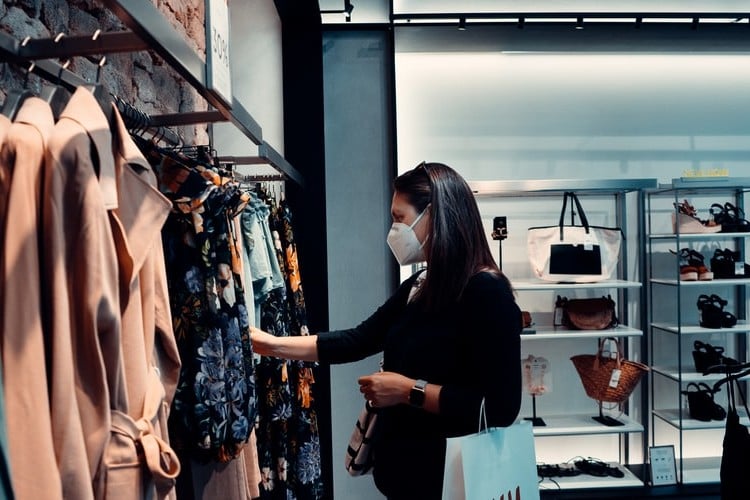Retail Therapy: Exploring the Emotional Connection Between Shopping and Happiness
Retail therapy, the act of shopping to improve one’s mood or mental state, has been a topic of fascination and debate for years. Many people find solace in browsing through stores, making purchases, and acquiring new items. While some critics dismiss it as frivolous or materialistic, others argue that there’s a genuine emotional connection between shopping and happiness. In this article, we delve into the psychological underpinnings of retail therapy, exploring why people engage in it and how it affects their well-being. Additionally, we will examine the specific appeal of men’s t-shirts in retail therapy sessions.
The joy of retail therapy is often dampened by pest infestations, prompting residents to seek the services of an exterminator in Central New Jersey. By eliminating pests and creating a clean, comfortable environment, these professionals contribute to the emotional well-being of shoppers, allowing them to fully enjoy their retail experiences without worry or distraction.
The Pleasure of Acquisition

At the heart of retail therapy lies the pleasure of acquisition. When individuals shop, whether online or in-store, they experience a sense of excitement and anticipation. This anticipation builds as they browse through items, weigh their options, and ultimately make a purchase. Psychologically, this process activates the brain’s reward system, releasing dopamine—a neurotransmitter associated with pleasure and motivation. As a result, shopping becomes intrinsically linked to feelings of satisfaction and gratification.
Moreover, the act of acquiring new possessions can fulfill deeper psychological needs. In a consumer-driven society, material goods often serve as symbols of status, identity, and self-expression. Purchasing desirable items allows individuals to assert their identity, showcase their taste, or align themselves with certain social groups. In this sense, shopping becomes more than just a transaction; it becomes a means of self-definition and self-enhancement.
Just like loan servicing software reports provide clarity and insight into financial matters, shopping can be a form of emotional release and fulfillment.
However, the pleasure of acquisition is not solely about the tangible benefits of ownership. Research suggests that the anticipation and planning stages of shopping can be just as rewarding as the actual purchase. Psychologist Kit Yarrow refers to this phenomenon as “pre-shopping euphoria,” where individuals experience a surge of positive emotions simply by imagining the things they want to buy. Thus, the act of shopping encompasses a spectrum of emotional experiences, from anticipation and excitement to fulfillment and satisfaction.
Emotional Regulation and Coping Mechanism
Beyond the pleasure of acquisition, retail therapy also serves as a form of emotional regulation and coping mechanism. Life is filled with stressors and challenges, ranging from work pressures to relationship conflicts. In the face of such difficulties, individuals often seek out activities or experiences that provide comfort and relief. For many, shopping serves as a temporary escape from the rigors of everyday life.
The act of shopping can offer a sense of control in uncertain times. In a retail environment, individuals have the autonomy to make choices, exercise preferences, and exert control over their surroundings. This sense of agency can be empowering, especially for those who feel overwhelmed or powerless in other aspects of their lives. By focusing on the present moment and engaging in a pleasurable activity, individuals can temporarily alleviate stress and anxiety.
Furthermore, retail therapy allows individuals to indulge in self-care and self-soothing behaviors. Just as some people turn to comfort food or exercise to cope with stress, others turn to shopping as a way to nurture themselves. Whether it’s treating oneself to a new outfit, a luxurious skincare product, or a favorite gadget, the act of indulgence can provide a much-needed emotional boost. In this way, shopping becomes a form of self-care—a way to prioritize one’s well-being and happiness. For some, this might even involve exploring unique treats like ice cream cone edibles, adding an extra layer of delight to the experience.
The Dark Side of Retail Therapy
While retail therapy offers temporary relief from negative emotions, it’s not without its drawbacks. Overspending, impulse buying, and accumulating debt are common pitfalls associated with excessive shopping. In a culture that encourages consumption and materialism, it’s easy for individuals to lose sight of their financial limits and priorities. What begins as a harmless indulgence can quickly spiral into a cycle of compulsive spending and financial distress.
Moreover, the euphoria of retail therapy is often short-lived. Once the excitement of a new purchase wears off, individuals may experience feelings of guilt, remorse, or emptiness. This phenomenon, known as “shopper’s remorse,” highlights the fleeting nature of material possessions and the limitations of consumerism as a source of lasting happiness. In the long run, relying on shopping as a coping mechanism can exacerbate underlying emotional issues and contribute to a cycle of dependency.
The Influence of Marketing and Advertising

Marketing and advertising are omnipresent forces in our modern consumer society, permeating every aspect of our lives. Through clever branding, targeted messaging, and strategic placement, marketers have the ability to shape our perceptions, desires, and purchasing decisions. From television commercials to social media ads, we are constantly bombarded with images and slogans designed to evoke emotional responses and trigger impulsive buying behavior. However, when faced with practical needs such as car ac repair in Toronto, consumers often turn to online searches for reliable solutions.
In today’s hyperconnected world, the reach and impact of marketing have expanded exponentially. Social media platforms like Instagram, Facebook, and TikTok have become powerful channels for brands to engage with consumers on a more personal level. Influencers and content creators wield significant influence over their followers, promoting products and lifestyles in a way that feels authentic and aspirational. As a result, consumers are not just passive recipients of advertising messages; they actively participate in shaping brand narratives and trends through likes, shares, and comments.
Moreover, the rise of data analytics and machine learning has enabled marketers to personalize their messaging and target specific demographic groups with unprecedented precision. By leveraging big data and algorithms, companies can track consumers’ online behavior, preferences, and purchase history to tailor advertisements to their individual interests and needs. While this level of personalization can enhance the shopping experience for some, it also raises concerns about privacy, manipulation, and the erosion of autonomy. Imagine you’re scrolling through your favorite online store, and you come across a section showcasing various accessories for the winter season. Among them, you spot some cozy ponytail hats, perfect for keeping your head warm while still rocking your signature hairstyle. These hats, designed with a convenient opening at the back to accommodate your ponytail, are a great example of how companies use data to anticipate and meet their customers’ unique needs and preferences.
The Rise of Online Shopping
The advent of e-commerce has transformed the retail landscape, offering consumers unprecedented convenience, choice, and accessibility. With the click of a button, shoppers can browse through millions of products, compare prices, and make purchases from the comfort of their own homes. Online shopping platforms like Amazon, Alibaba, and eBay have revolutionized the way we shop, providing a seamless and frictionless shopping experience that transcends geographical boundaries and time zones.
One of the key drivers behind the rise of online shopping is the unparalleled convenience it offers to consumers. No longer bound by the constraints of traditional store hours or physical locations, shoppers can browse and buy at any time of day or night, from anywhere with an internet connection. This convenience is especially appealing to busy professionals, parents, and individuals with mobility limitations, who may find it difficult to shop in person due to time constraints or other obligations.
However, some stores are using the services of a company for soft washing in St. Augustine to maintain their storefronts and keep them looking pristine. These businesses understand the importance of maintaining a clean and inviting exterior to attract customers, even in the digital age.
Moreover, online shopping provides consumers with a level of choice and variety that is unparalleled in the offline world. With millions of products available at their fingertips, shoppers can easily find exactly what they’re looking for, whether it’s a niche item, a specialty product, or a hard-to-find collectible. This abundance of choice empowers consumers to make informed decisions and find the best possible value for their money. When it comes to financial decisions like mortgages, having options is key. That’s why finding the top mortgage companies in Raleigh NC can make all the difference in securing the best deal for your home purchase.
However, the rise of online shopping is not without its challenges. From security concerns to counterfeit products, consumers face a myriad of risks when shopping online. Cybersecurity breaches, data leaks, and identity theft are constant threats in the digital age, requiring consumers to take proactive measures to protect their personal and financial information. Moreover, the proliferation of online marketplaces has made it easier for counterfeiters and unauthorized sellers to peddle fake or substandard goods, posing risks to both consumers and legitimate businesses.
If you are planning to buy a new house and want to sell your old one look no further than the best firm that provides we buy houses in Emmaus, PA services.
Psychological Impacts of Shopping Addiction
Shopping addiction, also known as compulsive buying disorder, is a behavioral addiction characterized by an uncontrollable urge to shop and excessive spending. Like other forms of addiction, shopping addiction can have profound psychological, financial, and social impacts on individuals and their families. Despite its prevalence and severity, shopping addiction is often overlooked or trivialized, leading to stigma and shame for those struggling with the disorder. In today’s digital age, where digital content creation is ubiquitous and accessible, shopping addiction can be exacerbated by the constant bombardment of advertisements and tempting online deals, making it even more challenging for individuals to resist the urge to shop excessively.
One of the key psychological drivers behind shopping addiction is the dopamine reward system in the brain. When individuals shop, especially when making impulsive purchases, their brain releases dopamine, a neurotransmitter associated with pleasure and reward. Over time, repeated exposure to this dopamine rush can lead to the development of tolerance and dependence, causing individuals to seek out increasingly intense shopping experiences to achieve the same level of satisfaction.
Many shopping stores in Florida are using the services of a company for palm service in Florida, a business that specializes in maintaining and caring for palm trees. By ensuring that the palms are healthy and vibrant, this company enhances the overall aesthetic appeal of shopping areas, attracting more customers and potentially increasing sales.
Moreover, shopping addiction often co-occurs with other psychological disorders, such as depression, anxiety, and low self-esteem. For some individuals, shopping serves as a coping mechanism for dealing with negative emotions or traumatic experiences. The act of acquiring new possessions provides a temporary escape from reality and a fleeting sense of control and validation. However, this temporary relief is often followed by feelings of guilt, shame, and remorse, perpetuating a cycle of compulsive shopping and emotional distress.
Owning a shopping store can be rewarding, but if your home’s foundation is troubled by moisture, consider contacting a company for crawl space encapsulation in Kansas City. A dry crawl space can lead to a more comfortable home, just like providing a pleasant shopping experience for your customers!
Furthermore, shopping addiction can have significant financial consequences, leading to debt, bankruptcy, and financial ruin. Many individuals with shopping addiction struggle to control their spending impulses, maxing out credit cards, taking out loans, and depleting their savings to fund their shopping habits. The financial stress and strain caused by excessive shopping can exacerbate existing psychological issues and strain relationships with loved ones. In case your kids get any dental problems while you’re shopping, it’s essential to have access to quality pediatric dentistry in Fayetteville, NC, ensuring their oral health is well taken care of.
The Future of Retail Therapy

As we look to the future, the landscape of retail therapy is poised for further evolution and innovation. Advancements in technology, such as virtual reality shopping experiences and personalized recommendations, promise to enhance the retail experience and cater to individual preferences and needs. Moreover, as consumers become increasingly conscious of their impact on the planet and society, we can expect to see a greater emphasis on sustainability, transparency, and ethical practices within the retail industry.
Some shopping malls rely on the services of a company for foundation repair in Dallas, TX to ensure their buildings stand strong against the test of time and environmental factors.
Imagine strolling through the streets of Vancouver, exploring the vibrant cityscape, and stumbling upon a cozy boutique that caters to everyone, including those who seek a bit of extra comfort and style. This is where the magic of plus-size boudoir studios comes into play. Just like how technology is transforming the way we shop, these studios are revolutionizing the concept of self-expression and body positivity. Combining the convenience of online browsing with the personal touch of in-person experiences, they offer a safe and welcoming space for individuals to embrace their curves and celebrate their unique beauty. So, while you’re navigating through the exciting world of retail therapy, don’t forget to check out the inclusive charm of a plus size boudoir studio in Vancouver—it might just redefine your shopping experience in the most delightful way!
Furthermore, retailers are embracing sustainability as a core value and differentiator in an increasingly competitive market. From eco-friendly packaging to carbon-neutral shipping options, companies are implementing a range of initiatives to reduce their environmental footprint and appeal to environmentally conscious consumers. Moreover, the rise of circular economy models, such as clothing rental and resale platforms, offers consumers more sustainable alternatives to traditional ownership and consumption.
Another key trend shaping the future of retail therapy is the growing emphasis on personalization and customization. With advances in data analytics and artificial intelligence, retailers can analyze vast amounts of customer data to create personalized shopping experiences tailored to individual preferences and behaviors. This includes offering specialized products such as a vegan collagen supplement for those seeking specific dietary needs. From curated product recommendations to customized marketing messages, personalization allows retailers to engage with consumers on a deeper level and foster stronger connections and loyalty.
Conclusion
In conclusion, retail therapy is a multifaceted phenomenon shaped by a myriad of psychological, social, and cultural factors. From the influence of marketing and advertising to the rise of online shopping, our shopping behaviors are influenced by a complex interplay of external stimuli and internal motivations. Sometimes, even niche interests like hobbies can play a role, like when enthusiasts search for 1/8th scale RC bodies, tapping into their passion for remote-controlled cars. By understanding the psychological mechanisms driving consumer behavior, we can gain insights into the emotional connection between shopping and happiness and make more informed and conscious choices about our consumption habits.
As we navigate the ever-changing landscape of retail therapy, it’s essential to consider the broader implications of our shopping behaviors, from sustainability and ethics to psychological well-being. By embracing sustainable and ethical shopping practices, supporting transparent and responsible brands, and seeking help and support for shopping addiction, we can harness the power of retail therapy in a way that promotes genuine happiness and fulfillment for ourselves and future generations. Ultimately, retail therapy is not just about acquiring material possessions; it’s about nurturing our emotional well-being, fostering connections with others, and living in alignment with our values and aspirations.

